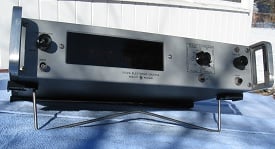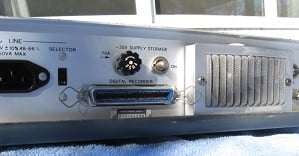Vintage Audio: HP 5512A Electronic Counter | Telos Alliance
By The Telos Alliance Team on Mar 6, 2014 9:31:26 AM
 Vintage Audio: HP 5512A Electronic Counter
Vintage Audio: HP 5512A Electronic Counter
A frequency counter is an essential tool on the electronic technician's test bench. For most of us, a reliable 1 Ghz counter is something that we take for granted. Early frequency counters however, were large, expensive, and their frequency range was only a few hundred kilohertz. But it was a start.
This month's attic discovery is an early 1970s HP 5512A Electronic Counter, a 300 Khz, 5-digit device that uses Nixie tubes for the display.
Inside the 5512, all the circuitry except the power supply is on removable printed circuit boards. Much of it is in the form of tubular electrolytics, 1/2-watt resistors and TO3 transistors - no integrated circuits to be found. A small fan keeps everything cool. As with all HP gear of this period, the quality of construction is superb.
Around back is a switch for internal/external time base, BNC connector for the time base, and oscillator frequency adjust. There's also a parallel port connector so the 5512 can be connected to a digital recording device.
While the upper frequency limit of these counters was quite modest, higher frequencies could be measured by several means. HP made heterodyne converter plug-in units for many of their counters. They would convert an unknown high frequency to a related frequency within the counter's basic range. Measurements up to 18 Ghz were possible with this technique.
Transfer oscillators could measure pulsed as well as CW signals. They required more operator skill and set-up time than heterodyne converters, and a longer gate time was needed for equivalent resolution. Prescaling was accomplished by frequency division of the input signal. If the gate time is extended with the proper scale factor, the correct frequency will appear on the readout. Most of these techniques have passed into the history books, since today's counters operate in the Gigahertz range right out of the box.
Early Digital Display with Nixie Tubes
 Modern frequency counters (and many other devices) would not be possible without some sort of digital display. Before the familiar 7-segment displays, there were Nixie tubes. Introduced in 1955 by a small vacuum tube manufacturer called Haydu Brothers Laboratories, they were originally used by Burroughs in mainframe computers. The name 'Nixie' was derived by Burroughs from "NIX I", an abbreviation of "Numeric Indicator eXperimental No. 1." They were manufactured by many firms, in many styles, from the 1950s through the 1990s.
Modern frequency counters (and many other devices) would not be possible without some sort of digital display. Before the familiar 7-segment displays, there were Nixie tubes. Introduced in 1955 by a small vacuum tube manufacturer called Haydu Brothers Laboratories, they were originally used by Burroughs in mainframe computers. The name 'Nixie' was derived by Burroughs from "NIX I", an abbreviation of "Numeric Indicator eXperimental No. 1." They were manufactured by many firms, in many styles, from the 1950s through the 1990s.
Use of Nixie tubes peaked in the late 1960s-early 1970s. As semiconductor technology advanced, 7-segment displays were developed. These had the advantages of not requiring high voltage power supplies and being more rugged. As a result, Nixie tubes soon fell out of favor in new display designs.
Nixies are cold-cathode vacuum tubes. The envelope contains a low-pressure gas, typically neon, mercury vapor or argon. The elements include a wire-mesh anode and multiple cathodes, shaped like alphanumeric symbols. When power is applied to one of the cathodes, it emits that familiar orange glow.
Still Taking Accurate Measurements.... if a bit Slowly
 This particular 5512 came from a dumpster-diving expedition. It’s in great shape cosmetically, but even more surprising, worked perfectly the first time it was plugged in. It had all the original electrolytic capacitors, which dated to 1970. After it warmed up for about 30 minutes, the 100 Kc internal oscillator was checked with a modern counter. Its frequency was about six percent high. Once adjusted, the HP 5512 tracked perfectly with a new counter as frequencies were measured from 5 Hz to 320 Khz. The biggest difference between the 5512 and newer counters is the time to take a measurement; modern counters measure a 1 Khz sample in the blink of an eye, while older counters can take 8-10 seconds.
This particular 5512 came from a dumpster-diving expedition. It’s in great shape cosmetically, but even more surprising, worked perfectly the first time it was plugged in. It had all the original electrolytic capacitors, which dated to 1970. After it warmed up for about 30 minutes, the 100 Kc internal oscillator was checked with a modern counter. Its frequency was about six percent high. Once adjusted, the HP 5512 tracked perfectly with a new counter as frequencies were measured from 5 Hz to 320 Khz. The biggest difference between the 5512 and newer counters is the time to take a measurement; modern counters measure a 1 Khz sample in the blink of an eye, while older counters can take 8-10 seconds.
While companies plan elaborate stress tests to evaluate the durability of their equipment, some of the most dramatic demonstrations are the result of accidents. A 1969 edition of HP Bench Briefs described what happened when the temperature regulator for a test chamber at HP failed and baked a counter at 203 degrees F. “The readout's plastic window melted and shriveled...some of the knobs and pushbuttons cracked...the OVERFLOW lamp popped out. When cooled to room temperature again, this integrated-circuit electronic counter still met its extensive performance specs in measuring frequency, time interval, period and frequency ratio.”
Telos Alliance has led the audio industry’s innovation in Broadcast Audio, Digital Mixing & Mastering, Audio Processors & Compression, Broadcast Mixing Consoles, Audio Interfaces, AoIP & VoIP for over three decades. The Telos Alliance family of products include Telos® Systems, Omnia® Audio, Axia® Audio, Linear Acoustic®, 25-Seven® Systems, Minnetonka™ Audio and Jünger Audio. Covering all ranges of Audio Applications for Radio & Television from Telos Infinity IP Intercom Systems, Jünger Audio AIXpressor Audio Processor, Omnia 11 Radio Processors, Axia Networked Quasar Broadcast Mixing Consoles and Linear Acoustic AMS Audio Quality Loudness Monitoring and 25-Seven TVC-15 Watermark Analyzer & Monitor. Telos Alliance offers audio solutions for any and every Radio, Television, Live Events, Podcast & Live Streaming Studio With Telos Alliance “Broadcast Without Limits.”
Recent Posts
Subscribe
If you love broadcast audio, you'll love Telos Alliance's newsletter. Get it delivered to your inbox by subscribing below!